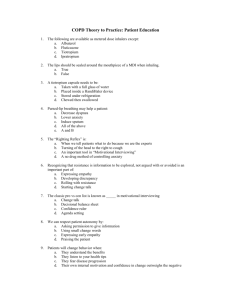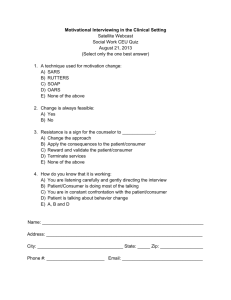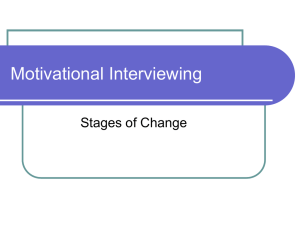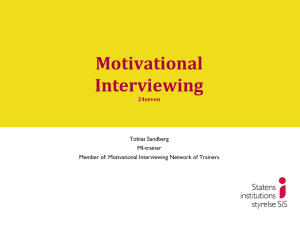FIVE GENERAL PRINCIPLES OF MOTIVATIONAL INTERVIEWING
advertisement
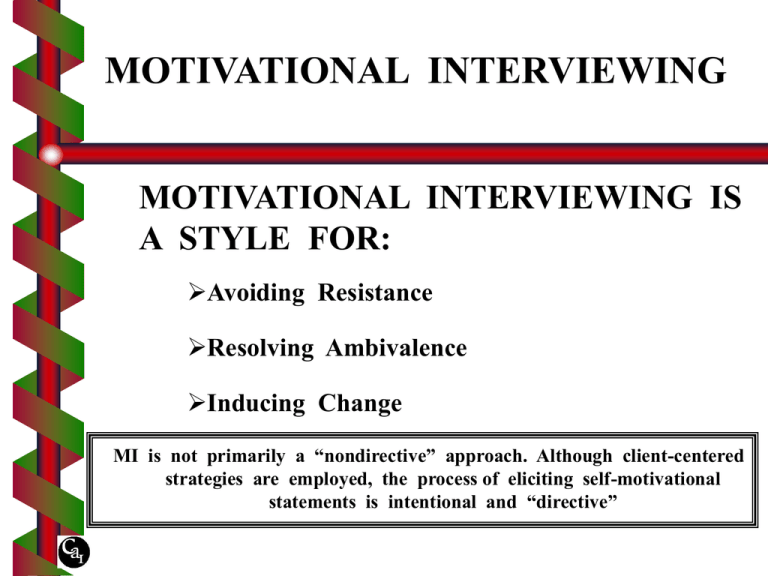
MOTIVATIONAL INTERVIEWING MOTIVATIONAL INTERVIEWING IS A STYLE FOR: Avoiding Resistance Resolving Ambivalence Inducing Change MI is not primarily a “nondirective” approach. Although client-centered strategies are employed, the process of eliciting self-motivational statements is intentional and “directive” RATIONALE AND BASIC PRINCIPLES Motivational Interviewing • • • Assumes that responsibility and capability for change lies within the client Therapist’s task is to create a set of conditions that will enhance the client’s own motivation for and commitment to change Mobilize the clients inner resources, helping relationships, support intrinsic motivation for change FIVE BASIC PRINCIPLES • Express Empathy • Develop Discrepancy • Avoid Argumentation • Roll with Resistance • Support Self-efficacy FIVE GENERAL PRINCIPLES OF MOTIVATIONAL INTERVIEWING EXPRESS EMPATHY by communicating acceptance of clients as they are, they are freed to change. Seek to compliment not denigrate (build up) More listening, not telling Gentle persuasion DEVELOP DISCREPANCY to help clients see and feel how their current behavior threatens important personal goals or is inconsistent with more central personal values. FIVE GENERAL PRINCIPLES OF MOTIVATIONAL INTERVIEWING AVOID ARGUMENTATION counterproductive makes clients defensive resistance may indicate a need to change strategies ROLL WITH RESISTANCE use resistance to help build motivation reframe statements acknowledge ambivalence as natural FIVE GENERAL PRINCIPLES OF MOTIVATIONAL INTERVIEWING SUPPORT SELF - EFFICACY explore past successes in other problem areas and apply to present situation. Client is responsible for choosing and carrying out personal change. THOUGHTS FROM RESEARCH This treatment strategy does not guide a client step-bystep through recovery It employs motivational strategies to mobilize the client’s own change resources It looks at motivating clients through short/brief encounters There is evidence that the therapeutic “style” forms the core of Motivational Interviewing • Accurate empathy (Rogers) There are six elements that have been described as active ingredients of the relatively brief interventions that have been shown to induce change in problem behaviors: F.R.A.M.E.S FRAMES FEEDBACK very persuasive use information from an objective intake evaluation as a basis for feedback to build motivation should be personal, not about general dangers of substance abuse RESPONSIBILITY emphasis on client’s personal responsibility and freedom of choice FRAMES ADVICE giving client clear and direct advice as to the need for change and how it might be accomplished should be given in a supportive, not authoritarian (domineering) way MENU to facilitate choice there must be alternatives from among which to choose there’s more than one “right way” to change FRAMES EMPATHY maintain a clientcentered approach, listening to and reflecting feelings. the opposite of confrontation SELF - EFFICACY communicating optimism that change can be achieved. Helping clients develop necessary skills to change encourage client to feel s/he can change. PHASE I BUILDING MOTIVATION FOR CHANGE ASSESS CLIENT’S CURRENT SITUATION IDENTIFY PROBLEMS OR ISSUES EVOKE SELF-MOTIVATIONAL STATEMENTS PHASE I BUILDING MOTIVATION FOR CHANGE FIVE EARLY STRATEGIES IN MI: OPEN-ENDED QUESTIONS REFLECTIVE LISTENING AFFIRMING SUMMARIZING ELICITING SELF-MOTIVATIONAL STATEMENTS AFFIRMING Compliments and statements of appreciation and understanding Shows respect for client and their efforts “I appreciate how hard it must have been for you to …” “I think it is great that you…” “That must have been difficult for you” “You’re certainly a resourceful person, to have…” “That’s a real good question” SUMMARIZING Used to link together material that has been discussed. Should be done periodically. Reinforces what has been said. Shows that you have been listening carefully. Prepares the client to move on. One of the more “directive” applications of MI COMPONENTS OF A GOOD SUMMARY STATEMENT Restates client’s statements regarding problem recognition, concern, reasons for change, and optimism about the change If client is ambivalent, it is useful to capture both sides (double-sided reflections) It is legal to include information from other sources (I.e., family, courts, other counselors, etc.) Don’t ramble - be concise End with an invitation for client to respond: How did I do? If this is a fair summary, are there other points? Is there anything you want to correct or add? GOALS FOR EVOKING SELFMOTIVATIONAL STATEMENTS How client sees the problem What the client’s concerns are about the problem Intention to change Belief in their ability to change (optimism) STRATEGIES AND TECHNIQUES FOR EVOKING SELF-MOTIVATIONAL STATEMENTS EVOCATIVE QUESTIONS using open-ended questions to ask for statements DECISIONAL BALANCE discussing pros and cons ELABORATION asking for examples or clarifications USING EXTREMES imagining the worst consequences LOOKING BACK remembering times before the problem, and comparing to present situation STRATEGIES AND TECHNIQUES FOR EVOKING SELF-MOTIVATIONAL STATEMENTS LOOKING FORWARD envisioning a changed future EXPLORING GOALS discussing client’s most important values and/or goals PARADOX agreeing with client’s perception of “no problem” in order to evoke the opposite behavior USING ASSESSMENT / FEEDBACK TO BOOST MOTIVATION WHAT ASSESSMENT RESULTS TO COVER IN FEEDBACK? Choose parts of the assessment / evaluation package already used, e.g. Results of any medical tests Results of diagnostic interview / checklist Any test scores / results that compare clients to others (the general population / norms) Problem areas that are related to substance use (e.g. Employment, family problems) USING ASSESSMENT RESULTS / FEEDBACK WITH WHAT STYLE TO GIVE FEEDBACK? Empathy - check in with client to see their reaction to feedback. Try to keep resistance down to they can “take in” feedback and use it Developing Discrepancy Avoid Argumentation Roll With Resistance don’t insist the client accept everything you’re saying Self-Efficacy encourage client; be optimistic about change PHASE II STRENGTHENING COMMITMENT TO CHANGE SIGNS OF READINESS FOR CHANGE Decreased resistance Decreased questions about the problem Resolve Self-motivational statements Increased questions about change Envisioning Experimenting PHASE II STRENGTHENING COMMITMENT TO CHANGE Client is ready to change Client has not made a firm commitment to change Contemplation / Preparation PHASE II STEPS TO STRENGTHENING COMMITMENT TO CHANGE RECAPITULATION summarize the client’s current situation based on your interaction in order to evaluate what to do next KEY QUESTIONS ask clients what they want to do use open-ended questions encourages client to reflect and talk about change PHASE II STEPS TO STRENGTHENING COMMITMENT TO CHANGE INFORMATION AND ADVICE in response to client questions, provide the information or ideas wait for invitation from client to provide advice do not fall prey to the “yes, but” pattern NEGOTIATING A PLAN set goals consider change options arrive at a plan PHASE II STRENGTHENING COMMITMENT TO CHANGE HAZARDS Understanding Ambivalence does not disappear quickly Overprescription developing a plan that is unacceptable to the client Insufficient direction providing too little guidance / direction NON-VERBAL ROLES What it was like growing up in my home Ways in which I have changed as a person over the years The good things and not so good things about my high school years What I hope and plan to do over the next ten years Describe one of your parents, or someone else close to you How I came to do the kind of work I am doing

